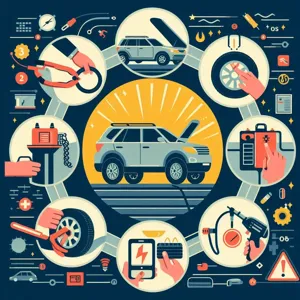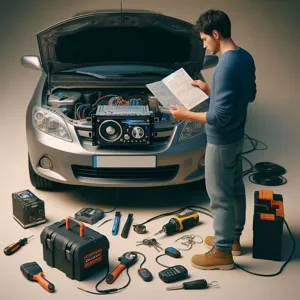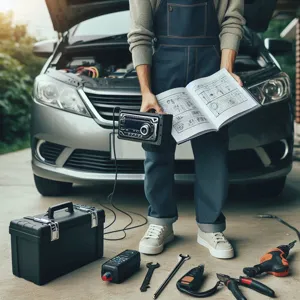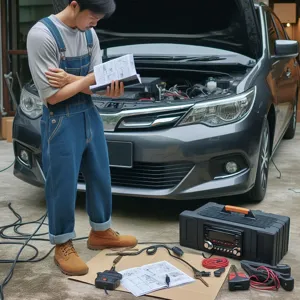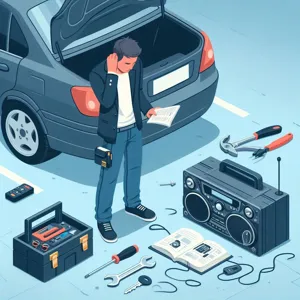When it comes to towing trailers, whether for a weekend getaway, a cross-country move, or hauling your favorite toys, having the right vehicle can make all the difference.
The perfect towing vehicle needs to combine power, performance, and practicality, ensuring that you can confidently handle heavy weights while enjoying a smooth drive. In this blog post, we’ll explore the top 10 best cars for towing trailers, highlighting their impressive towing capacities, robust engine performance, and advanced features designed to enhance safety and ease of use. From rugged SUVs to capable trucks, these vehicles are engineered to tackle the demands of towing with style and efficiency. Join us as we dive into the world of towing, helping you choose the ideal companion for your adventures on the road!
1. Introduction to Towing Capacity and Importance
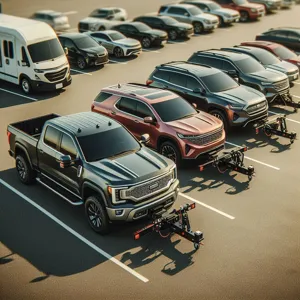
When it comes to towing trailers, understanding the concept of towing capacity is essential for any prospective vehicle owner. Towing capacity refers to the maximum weight a vehicle can safely tow, taking into account its engine power, drivetrain, and overall structural integrity. It’s not just a number; it’s a critical factor that ensures your safety on the road and the protection of your valuable cargo.
Whether you’re planning a weekend getaway with a travel trailer, moving your boat to the lake, or hauling a heavy load for work, knowing your vehicle’s towing capabilities helps you make informed decisions. Exceeding the recommended towing capacity can lead to disastrous consequences, including loss of control, increased wear and tear on your vehicle, and potential legal issues.
In this guide, we’ll explore the top 10 best cars for towing trailers, where power meets performance—vehicles that not only excel in their towing capacities but also provide the reliability and comfort you need for your journeys. From rugged trucks designed for heavy hauls to versatile SUVs that can handle the load with grace, we’ll help you find the perfect match for your towing needs. Get ready to discover how these vehicles can empower your adventures while ensuring you stay safe and secure on the road.
2. Key Factors to Consider When Choosing a Towing Vehicle
When it comes to choosing the right vehicle for towing trailers, several key factors must be taken into account to ensure a smooth and safe experience. Understanding these elements not only helps in selecting a vehicle that meets your towing needs but also enhances your overall driving experience.
**1. Towing Capacity:** This is the most critical factor. Each vehicle comes with a specific towing capacity, which dictates how much weight it can safely pull. It’s essential to check the manufacturer’s specifications for both the maximum towing capacity and the gross vehicle weight rating (GVWR) to avoid overloading your vehicle.
**2. Engine Power and Torque:** A vehicle’s engine power and torque ratings directly affect its towing performance. Higher torque ratings are particularly important for towing, as they provide the necessary strength to get heavy loads moving and maintain speed on inclines. Look for vehicles with robust engines, often found in trucks and SUVs, which are designed for demanding towing tasks.
**3. Transmission Type:** The type of transmission—automatic or manual—can also play a role in towing efficiency. Automatic transmissions often come with towing modes that optimize performance by adjusting shift points, while manual transmissions can give drivers more control over gear selection, which can be beneficial in hilly terrain.
**4. Trailer Brake system:** If you plan on towing heavier trailers, it’s crucial to consider the brake system. Many modern vehicles are equipped with integrated trailer brake controllers that allow you to synchronize the vehicle and trailer brakes, enhancing safety and control during braking.
**5. stability and Suspension:** The vehicle’s suspension system affects how well it handles the added weight of a trailer. Look for vehicles with a robust suspension system that includes features like load-leveling technology, which helps maintain stability and ride height when towing.
**6. Hitch Compatibility:** Not all vehicles come with the same hitch configurations. Ensure that the vehicle you choose can accommodate the type of hitch required for your trailer. This includes checking the receiver size and weight rating to ensure compatibility.
**7. Fuel Efficiency:** While not the first thing that comes to mind when considering towing, fuel efficiency is still an important factor, especially for long trips with heavy loads. Look for vehicles that offer a balance between power and fuel economy to help manage costs over time.
**8. Cargo Space:** Lastly, consider the amount of cargo space available in addition to towing capacity. If you’re planning to travel with passengers and gear, ensure that the vehicle has ample room to accommodate everything comfortably.
By carefully considering these factors, you’ll be better equipped to choose a vehicle that not only meets your towing needs but also enhances your overall driving experience, ensuring that your adventures on the road are both enjoyable and safe.
3. Overview of Trailer Weight Ratings
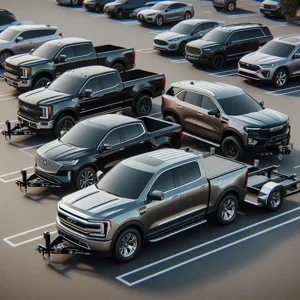
When it comes to towing trailers, understanding trailer weight ratings is crucial for ensuring both safety and performance on the road. These ratings are essential metrics that indicate how much weight a vehicle can safely tow, and they consist of several key components: Gross Vehicle Weight Rating (GVWR), Gross Trailer Weight (GTW), and Tongue Weight (TW).
**Gross Vehicle Weight Rating (GVWR)** refers to the maximum weight a vehicle can safely carry, including its own weight plus any cargo, passengers, and the trailer it’s towing. When selecting a towing vehicle, it’s imperative to consider this rating to avoid overloading, which can lead to decreased handling and increased wear on your vehicle.
**Gross Trailer Weight (GTW)** is the total weight of the trailer and all its contents. This rating is vital to know because it provides a clear picture of the towing capacity you require. Each vehicle has its own GTW limit, and exceeding this limit can compromise stability and braking effectiveness, making it a significant safety concern.
**Tongue Weight (TW)** is the downward force exerted on the hitch by the trailer coupler. Generally, this should be about 10-15% of the total trailer weight to ensure optimal towing performance. If the tongue weight is too low, the trailer can sway, while too high a weight can overload the rear axle of the tow vehicle, leading to poor handling.
In summary, being well-versed in these weight ratings will help you choose the right vehicle for your towing needs. It ensures that you maintain both legal compliance and safety standards while enjoying the convenience of towing. Whether you’re hauling a travel trailer for family vacations or a utility trailer for work, understanding these ratings will guide you toward making an informed decision about the best cars for towing trailers.
4. Criteria for Selecting the Best Towing Cars
When it comes to selecting the best cars for towing trailers, several key criteria should guide your decision-making process. Towing is not just about raw power; it’s a blend of multiple factors that ensure safety, efficiency, and performance on the road.
**1. Towing Capacity:** The first and foremost consideration is the vehicle’s towing capacity, which is typically measured in pounds. This figure indicates how much weight the vehicle can safely tow. Always choose a car with a towing capacity that exceeds the weight of your trailer and its cargo to account for any additional stresses that may arise during travel.
**2. Engine Power and Torque:** A robust engine is essential for towing. Look for vehicles equipped with high-torque engines that can deliver the necessary power to pull heavy loads uphill or through challenging terrains. Diesel engines often provide superior torque, making them ideal for towing larger trailers.
**3. Stability and Control:** Towing a trailer can alter a vehicle’s dynamics, so stability is crucial. Opt for cars with advanced suspension systems, trailer sway control, and rear-wheel drive setups. These features help maintain control and ensure a smooth ride, even when navigating sharp turns or uneven surfaces.
**4. Braking System:** The ability to stop effectively is paramount when towing. Vehicles equipped with strong braking systems, including integrated trailer brakes, provide better stopping power and safety. Anti-lock braking systems (ABS) can also enhance control during sudden stops.
**5. Payload Capacity:** Beyond towing capacity, consider the payload capacity, which refers to how much weight a vehicle can carry in its cabin and bed. This is important if you plan to transport additional equipment or cargo alongside your trailer.
**6. Fuel Efficiency:** Towing can significantly impact fuel consumption. Look for vehicles that offer a balance between power and fuel efficiency, allowing you to travel longer distances without breaking the bank on gas.
**7. Comfort and Features:** Remember that towing usually involves long journeys, so comfort is essential. Choose a car that provides a comfortable interior, ample storage space, and modern features like navigation, infotainment systems, and driver-assist technologies for a more enjoyable travel experience.
**8. Reliability and Brand Reputation:** Finally, consider the reliability of the brand and model. Research reviews and consumer reports to ensure you’re selecting a vehicle known for its durability and performance under towing conditions.
By focusing on these criteria, you’ll be well-equipped to find a towing vehicle that not only meets your needs but also enhances your overall towing experience, ensuring that power meets performance on every adventure.
5. #1: Ford F-150 – Power and Versatility

When it comes to towing trailers, the Ford F-150 stands tall as a leader in its class, seamlessly blending power with versatility. This iconic truck has earned its reputation over decades of performance, and it’s easy to understand why it consistently ranks as the go-to choice for both casual drivers and dedicated towing enthusiasts.
Equipped with a robust engine lineup, the F-150 offers various powertrain options, including the formidable 3.5-liter EcoBoost V6, which boasts an impressive towing capacity of up to 14,000 pounds when properly configured. Whether you’re hauling a heavy camper for a weekend getaway or transporting equipment for work, the F-150’s potent engine ensures you have the muscle needed to get the job done without breaking a sweat.
But power is just part of the story. The F-150 excels in versatility, offering a range of cab configurations and bed sizes to suit your specific needs. Choose from the spacious SuperCrew for family trips or the extended SuperCab for additional cargo space—there’s a setup for every scenario. Additionally, the truck is designed with a high-strength, lightweight aluminum body, enhancing fuel efficiency without compromising durability.
Inside, the F-150 is just as impressive. It features modern technology that includes Ford’s innovative towing assist features, which help you monitor and manage your load effectively. From integrated trailer brake controllers to advanced safety features, the F-150 prioritizes your peace of mind while towing.
With its combination of raw power, intelligent design, and advanced technology, the Ford F-150 is not just a truck—it’s a towing powerhouse that adapts to the demands of any adventure, making it the top choice for those looking to tow trailers with confidence and ease.
6. #2: Chevrolet Silverado 1500 – Strength and Reliability
When it comes to towing, the Chevrolet Silverado 1500 stands out as a powerhouse that embodies strength and reliability. This full-size pickup truck is engineered for those who demand performance without sacrificing comfort. With a robust lineup of engines, including a 5.3-liter V8 and an available 6.2-liter V8, the Silverado 1500 delivers impressive towing capacities that can handle trailers, boats, and recreational vehicles with ease.
What sets the Silverado apart is not just its raw power, but also its thoughtful design and advanced technology. The truck features a high-strength steel frame and a well-balanced chassis, ensuring stability while hauling heavy loads. The available towing package enhances its capabilities further, offering features like a factory-installed hitch, an integrated trailer brake controller, and an advanced rearview camera system that assists with hitching and maneuvering.
Inside the Silverado, you’ll find a spacious and comfortable cabin equipped with modern conveniences. Premium materials, intuitive infotainment systems, and ample storage solutions make it a pleasure to ride in, whether you’re on a long road trip or just heading to the job site. The available Multi-Flex Tailgate adds versatility, making loading and unloading your gear a breeze.
With its combination of strength, reliability, and innovative features, the Chevrolet Silverado 1500 is not just a truck; it’s a dependable partner for any towing adventure. Whether you’re hauling a trailer for work or exploring the great outdoors, this vehicle ensures you’ll get there with confidence and style.
7. #3: Ram 1500 – Comfort and Capability

### 7. #3: Ram 1500 – Comfort and Capability
When it comes to towing trailers, the Ram 1500 stands out as a formidable contender, seamlessly blending comfort with impressive capability. This full-size pickup truck has garnered a loyal following for its robust performance and luxurious interior, making it an ideal choice for both work and leisure.
Under the hood, the Ram 1500 offers a range of powerful engine options, including a potent V8 that delivers remarkable towing capacity—up to 12,750 pounds when properly equipped. This means you can haul everything from a weekend camping trailer to a hefty boat without breaking a sweat. Its advanced towing features, such as the available integrated trailer brake controller and trailer sway control, provide added peace of mind, ensuring that your cargo remains stable and secure on the road.
But what truly sets the Ram 1500 apart is its interior. The cabin is a haven of comfort, with high-quality materials and thoughtful design. Spacious seating, ample legroom, and an intuitive infotainment system, complete with a large touchscreen and smartphone integration, make long trips enjoyable. Whether you’re navigating through rough terrains or cruising down the highway, the Ram 1500’s smooth ride quality ensures that you and your passengers arrive at your destination relaxed and refreshed.
In addition, the truck’s innovative storage solutions, such as the rear under-seat storage compartments and the versatile RamBox cargo management system, provide the perfect place for your towing gear and personal belongings. With the Ram 1500, you don’t just get a workhorse; you get a vehicle that caters to your lifestyle, making it one of the best options for towing trailers while ensuring comfort on every journey.
8. #4: Toyota Tundra – Dependability and Performance
When it comes to towing trailers, the **Toyota Tundra** stands out as a formidable contender, earning its place among the best options available. Renowned for its dependability and robust performance, the Tundra has established itself as a trusted companion for both recreational adventurers and hardworking professionals alike.
At the heart of the Tundra’s towing capability is its powerful V8 engine, which delivers an impressive horsepower and torque that can handle hefty loads with ease. With a maximum towing capacity of up to 10,200 pounds when properly equipped, this pickup truck is more than capable of hauling your trailer, boat, or camper without breaking a sweat. Its robust construction and advanced engineering ensure that whether you’re navigating steep inclines or cruising down the highway, the Tundra remains stable and secure, giving you peace of mind with every mile.
In addition to its raw power, the Tundra is outfitted with a suite of towing features that enhance its performance. The integrated Trailer Sway Control helps maintain control of your load, while the Tow/Haul mode optimizes the transmission for better acceleration and deceleration when towing. This attention to detail makes the Tundra not only a powerhouse but also an intuitive choice for those who frequently tow.
Comfort and technology don’t take a back seat in the Tundra, either. The spacious cabin is designed with both driver and passenger comfort in mind, featuring supportive seating and an array of modern technology, including a user-friendly infotainment system that keeps you connected on the road. Whether you’re heading out for a weekend getaway or tackling a tough job, the Toyota Tundra combines dependability and performance in a way that few others can match, making it a top choice for anyone looking to tow with confidence.
9. #5: GMC Sierra 1500 – Premium Features for Towing
The GMC Sierra 1500 stands tall as a formidable contender in the realm of trucks, merging rugged capability with an array of premium features designed to elevate your towing experience. Known for its robust performance, this full-size pickup is not only built to handle heavy loads but also offers an impressive suite of technology and comfort that sets it apart from the competition.
Under the hood, the Sierra 1500 boasts a choice of powerful engines, including a muscular V8 that delivers remarkable torque and horsepower, making towing trailers feel effortless. With a maximum towing capacity that can reach up to 12,200 pounds, the Sierra is well-equipped to handle everything from campers to work trailers, allowing you to transport your gear with confidence.
But it’s not just about brute strength; the Sierra 1500 excels in integrating advanced features that enhance towing safety and convenience. Its available ProGrade™ Trailering System provides comprehensive towing assistance, including an in-vehicle trailering app that offers customizable trailer profiles, pre-departure checklists, and even a built-in truck bed camera to help you hitch up with ease. This thoughtful technology ensures that even novice towers can navigate the challenges of towing with grace.
Moreover, comfort is paramount in the Sierra 1500. The spacious interior is adorned with high-quality materials, and available features such as heated and ventilated seats, a premium audio system, and a large touchscreen infotainment system create a luxurious driving experience. Whether you’re on a long road trip or simply making a quick run to the job site, the Sierra 1500 provides a smooth and enjoyable ride, making it a favorite among towing enthusiasts.
In summary, the GMC Sierra 1500 embodies the ideal blend of power, performance, and premium features, making it a top choice for those who demand excellence while towing. Whether you’re hauling a boat to the lake or transporting equipment for work, the Sierra ensures you do it in style and with confidence.
10. #6: Nissan Titan – A Robust Option for Heavy Loads
When it comes to towing heavy trailers, the Nissan Titan stands out as a robust option that combines power with impressive performance. This full-size pickup truck is engineered to handle demanding tasks with ease, making it a favorite among those who require a reliable towing vehicle.
Under the hood, the Titan boasts a formidable 5.6-liter V8 engine that churns out a staggering 400 horsepower and 413 lb-ft of torque. This potent powertrain allows the Titan to tow an impressive maximum capacity of up to 9,370 pounds, ensuring that even the heaviest of trailers are no match for its capabilities. Whether you’re hauling a fifth-wheel camper for a weekend getaway or a utility trailer for work, the Titan’s robust engine performance instills confidence on the road.
But it’s not just the engine that makes the Nissan Titan a standout choice for towing. The truck features a durable chassis and a sophisticated suspension system designed for stability and control, even when loaded to the max. With a reinforced frame and advanced trailer sway control technology, drivers can navigate sharp turns and uneven terrain with peace of mind, knowing their trailer is secure and manageable.
Moreover, the Titan’s spacious and comfortable cabin adds to its appeal. With supportive seating and an intuitive infotainment system, long journeys become enjoyable rather than exhausting. Plus, the truck is equipped with various towing aids, including a rearview camera with trailer guides, making hitching a breeze.
For those in search of a reliable, powerful truck that can handle heavy loads with grace, the Nissan Titan is a compelling option that doesn’t compromise on performance or comfort. Whether you’re a weekend adventurer or a professional in need of serious hauling capabilities, the Titan is ready to meet your towing needs, proving itself as a true powerhouse on the road.
11. #7: Jeep Grand Cherokee – Off-Road and Towing Excellence
When it comes to the perfect blend of off-road capability and towing prowess, the Jeep Grand Cherokee stands tall among its competitors. Renowned for its rugged design and refined interior, the Grand Cherokee offers a robust performance that appeals to adventure enthusiasts and families alike.
Equipped with a powerful engine lineup, including options like the 5.7-liter V8, the Grand Cherokee can tow up to 7,200 pounds, making it an ideal companion for hauling trailers, boats, or campers. Its sophisticated four-wheel-drive system ensures that you can tackle any terrain, whether you’re navigating rocky trails or forging through muddy paths.
What sets the Grand Cherokee apart is its thoughtful engineering that combines power with comfort. The spacious cabin is adorned with high-quality materials and advanced technology, ensuring that both driver and passengers enjoy a luxurious experience on any journey. Plus, with features like a user-friendly infotainment system and ample cargo space, you’ll have everything you need for long trips or weekend getaways.
Not to mention, the Grand Cherokee is equipped with state-of-the-art towing aids, including a rearview camera with dynamic guidelines and trailer sway control, giving you added confidence when maneuvering your load. Whether you’re planning an off-road expedition or simply need a reliable vehicle for your towing needs, the Jeep Grand Cherokee delivers the perfect balance of performance, comfort, and versatility.
12. #8: Subaru Ascent – Family-Friendly Towing
### #8: Subaru Ascent – Family-Friendly Towing
When it comes to finding a reliable vehicle that expertly balances family comfort with formidable towing capabilities, the Subaru Ascent stands out as a top contender. This three-row SUV is designed with families in mind, providing ample space for both passengers and gear, making it an ideal choice for those who love the great outdoors or simply need to haul around the kids and their equipment.
Under the hood, the Subaru Ascent is powered by a robust 2.4-liter turbocharged four-cylinder engine that delivers an impressive 260 horsepower and 277 lb-ft of torque. This powertrain allows the Ascent to confidently tow up to 5,000 pounds, which is more than sufficient for a variety of trailers, from campers to boats. This towing capacity is complemented by Subaru’s renowned symmetrical all-wheel drive system, ensuring stability and control even when navigating challenging terrains or adverse weather conditions.
Inside, the Ascent does not skimp on comfort or technology. With seating for up to eight passengers, it boasts spacious, well-appointed interiors that include high-quality materials and thoughtful design elements. Families will appreciate the versatility of the seating configuration, as well as the generous cargo space that expands when the back seats are folded down, making it easy to pack for weekend getaways or long road trips.
Additionally, the Ascent comes equipped with Subaru’s EyeSight Driver Assist Technology, which enhances safety on the road, particularly when towing. Features like adaptive cruise control, lane departure warning, and pre-collision braking help ensure that you and your family remain safe while enjoying your adventures.
For those who prioritize both family-friendly features and robust towing performance, the Subaru Ascent is a versatile and dependable option that truly excels in meeting the demands of today’s active lifestyle. Whether you’re hitting the road for a camping trip or hauling a trailer full of sports equipment, the Ascent is more than ready to take on the task.
13. #9: Honda Ridgeline – Innovative Design for Towing
The Honda Ridgeline stands out as an exceptional choice in the realm of towing capabilities, thanks to its innovative design and thoughtful engineering. With its unibody construction, the Ridgeline offers a combination of strength and versatility that is hard to find in traditional pickup trucks. This unique build not only enhances stability while towing but also contributes to a smoother ride, making it an excellent option for those who prioritize comfort alongside capability.
Under the hood, the Ridgeline is equipped with a robust 3.5-liter V6 engine that delivers a commendable 280 horsepower and 262 lb-ft of torque. This powertrain not only allows for a towing capacity of up to 5,000 pounds but also ensures that the vehicle remains agile and responsive, whether navigating city streets or tackling rugged terrain. Coupled with a six-speed automatic transmission, the Ridgeline provides seamless shifts and impressive acceleration, making it suitable for various towing scenarios.
What truly sets the Honda Ridgeline apart is its innovative cargo solutions. The flexible in-bed trunk and the dual-action tailgate enhance functionality, allowing for easy loading and unloading of gear, while the truck’s spacious interior provides ample room for passengers and their belongings. Additionally, with features like all-wheel drive and intelligent traction management, the Ridgeline ensures confident handling in various weather conditions, making it a reliable choice for those who frequently tow.
Whether you’re hauling a camper for a weekend getaway or transporting equipment for work, the Honda Ridgeline delivers a harmonious blend of power, performance, and practicality. Its commitment to innovative design not only elevates the towing experience but also reinforces Honda’s reputation for producing vehicles that are as versatile as they are dependable. For anyone in the market for a capable towing vehicle, the Ridgeline earns its place as a top contender on this list.
14. #10: Kia Telluride – A Surprising Contender
### 14. #10: Kia Telluride – A Surprising Contender
When you think of towing capacity and rugged performance, the Kia Telluride might not be the first vehicle that comes to mind. However, this mid-size SUV has rapidly earned a reputation as a surprisingly capable contender in the towing arena. With its bold design and spacious interior, the Telluride combines practicality with an impressive performance profile that appeals to families and adventurers alike.
Under the hood, the Telluride is equipped with a robust 3.8-liter V6 engine that generates 291 horsepower and 262 lb-ft of torque. This powerful engine, paired with an 8-speed automatic transmission, allows the Telluride to tow up to 5,000 pounds when properly equipped—enough muscle to handle most small to medium-sized trailers. Whether you’re hauling a camper for a weekend getaway or a boat for a day on the lake, the Telluride’s towing capabilities will meet your needs.
But the Telluride doesn’t just excel in power; it also boasts a sophisticated all-wheel-drive system that enhances stability and traction, especially under heavy load. This means drivers can confidently navigate various terrains and weather conditions while towing, ensuring a smooth and controlled ride. Additionally, the Telluride comes with an array of safety features, including a blind-spot monitoring system and rear cross-traffic alert, which add an extra layer of security when maneuvering with a trailer.
Inside, the Telluride offers ample space for both passengers and cargo, making it an ideal choice for families on the go. With three rows of seating and versatile cargo configurations, there’s plenty of room to accommodate everything from sports gear to camping equipment. The upscale interior is filled with modern amenities, including an intuitive infotainment system, which ensures that both driver and passengers remain comfortable and entertained during long journeys.
In summary, the Kia Telluride is more than just a stylish SUV; it’s a reliable towing machine that delivers on performance, comfort, and safety. For those in search of a vehicle that can handle the demands of towing without sacrificing everyday usability, the Telluride stands out as a compelling option in a crowded market.
15. Conclusion: Finding the Right Balance of Power and Performance
In conclusion, selecting the best car for towing trailers ultimately hinges on finding the right balance between power and performance. A vehicle that excels in sheer horsepower may not always deliver the handling and comfort required for a smooth towing experience, and conversely, a highly agile car may lack the necessary torque to manage heavier loads efficiently.
As we’ve explored in this guide, the ideal towing vehicle should not only boast an impressive towing capacity but also feature advanced stability control systems, proper weight distribution capabilities, and robust braking performance to ensure safety on the road. Factors such as engine size, drivetrain configuration, and axle ratios play crucial roles in determining how well a car can manage the demands of towing, particularly under challenging conditions.
When contemplating your options, also consider the type of trailer you’ll be towing, as well as the frequency and distance of your journeys. Whether you’re hauling a lightweight camping trailer for weekend getaways or a heavy-duty work trailer for professional needs, the right vehicle can make all the difference in your experience.
Ultimately, investing time in research and test-driving potential candidates will help you make an informed decision. By assessing your specific needs and preferences, you’ll be well-equipped to choose a towing vehicle that offers not just power, but also the performance and reliability you require to hit the road with confidence. With the right car by your side, you can enjoy the freedom of exploration, knowing that you’re well-prepared for any adventure that lies ahead.
In conclusion, the perfect combination of power and performance is essential when selecting a vehicle for towing trailers, and our list of the top 10 best cars has showcased some outstanding options that deliver on both fronts. Whether you’re an adventure enthusiast looking to haul your camper into the great outdoors or a weekend warrior needing a reliable truck for your utility trailer, these vehicles provide the capability and comfort you desire. Each model has been carefully selected for its towing capacity, engine performance, and overall reliability, ensuring you can confidently hit the road with your trailer in tow. As you embark on your journey to find the ideal towing vehicle, remember to consider not only the specifications but also how each car fits your lifestyle and needs. Happy towing, and may your travels be filled with exciting adventures and unforgettable memories!















